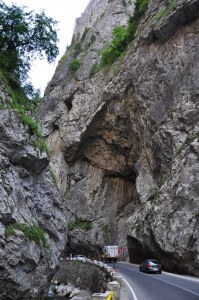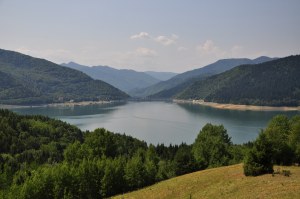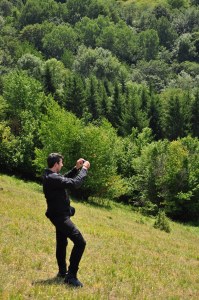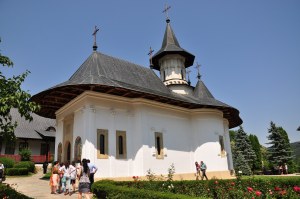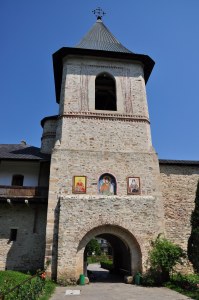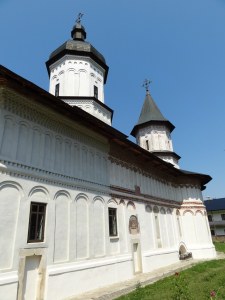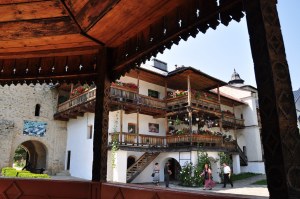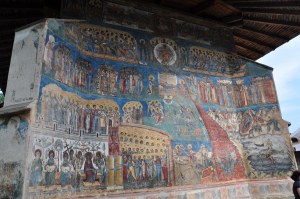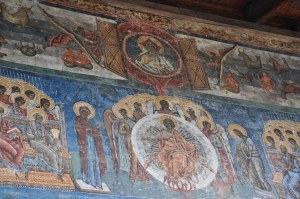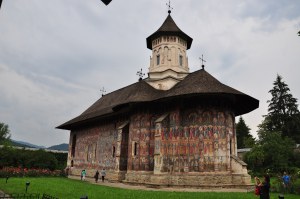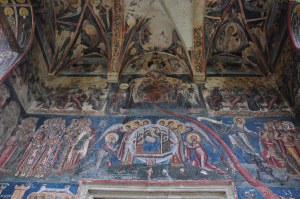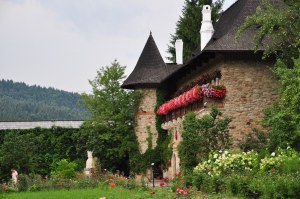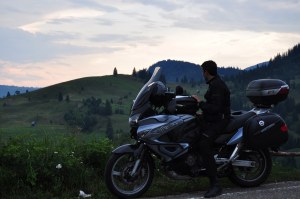We fell asleep early in the day before, so at 7am i opened my eyes. It was too many hours for me, so early and so much I hadn’t slept since I was a child. At 8:30am, we went for breakfast and we left at 10.30am... The morning delay seems to be a common feature with Stratos...
Within walking distance from our accommodation and the Lacul Rosu, it is the passage of Bicaz. This is a narrow canyon, formed by rocks of 300m height, the base of which lies below the road bed of a tributary of Bicaz. The spectacle is impressive and not a random one of the most known tastes of local and foreign motorcyclists and more! Many people visiting the area. There are many who choose to cross on foot (about 5km). In some places there are outdoor souvenir shops. We made the trip two times (although we would like even more...) and stopped at some places to photograph the magnificent spectacle!
We continue to Bicaz. The route crosses small villages, the houses which attracted our interest. It may have been poorly, but was neatly highlighting the taste of their owners. Most were made of wood, painted in different colors and some had and designs. The road was in good condition, while the increased movement -with the presence of some trucks- did not allow us to enjoy the route as we would like. In Bicaz town we followed the signs to Targu-Neamt.
From there began a pleasant path through a wooded area. Reaching the artificial lake Izvorul Muntelui we saw the big homonymous dam. The road that moves around and in many places we could enjoy wonderful views. The road was not in the best condition, and if we achieved a large vehicle, it was relatively difficult to overtake. At the point where the lake almost finished, we met a bridge with multiple arches. Following the right path, to Targu-Neamt, we continued in an equally beautiful way -with good condition of pavement - in a beautiful natural setting next to the river Bolatau. The appropriate conditions to enjoy driving! At the village of Leghin we met the junction for Sihastria and Secu monasteries, where we turned right to visit them. The route crossed an area with green fields on the edge of which there was a small river. In the shade of trees several groups had sat enjoying coolness and relaxation, roasting and eating, listening to music, and even celebrate a significant event, as did a gypsy gang!
In less than 10 km, we arrived at the monastery of Sihastria, while previously we overtake that of Secu, leaving it to visit next. The monastery of Sihastria has the architecture of the monasteries in the area. It resembles that of Voronet, but lacks paintings outdoors. In the past, the monastery operated by Father Cleopas, who was chased hard by the communist regime in Romania. The monastery is neat and many people visit it daily.
Nearby is the Secu monastery. It has perimeter walls, inside of which hosted the monks' cells and other auxiliary facilities. It's impressive! This monastery has a rich history, much of which is associated with the Greek chieftain, Georgaki Olympio, who defended the monastery, in order not to fall into the hands of the Turks, he bombed himself -along with other monks- at the spire.
The time was 2.30pm and we decided to stop in the shade of the tall trees. We drank our coffee and refreshed to continue to our next destination, the Voronet monastery. Arriving in Targu-Neamt, we followed the signs to Falticeni, which was the shortest route through a secondary country road in good condition. We arrived in the beautiful city of Gura Humorului, which also has a monastery. But the hour was already 4.15pm and we left directly for Voronet, which was about 5km.
Once we reached the monastery I realized how much has changed in the surrounding area since 2007. In addition to the vehicles it was not possible to reach up to the monastery gate. There were parking spaces on payment, a flea market and various accommodations. We parked our bikes and headed to the monastery. Personally I like and I recommend it. It had a lot of people and after we paid the price of 5 RON, we got to enjoy it.
Most monasteries in the area were built by Stefan cel Mare, a legendary figure in Romania. Its architecture combines the division and isolation of the monastery but defensive role for the local people in times of hostile attacks. Another peculiarity is the fact that it is crafted their outer walls. The paintings depict images from the Old Testament, Revelation, the crisis, the life and martyrdom of saints, the genealogy of Christ, the life of the Virgin, Saints images, angels, prophets, etc. The multiple representations were educational role for the inhabitants of each region mostly illiterate peasants. Each monastery is dedicated to religious form and presents a particularity. In Voronet is characteristic blue color that dominates the paintings. Indeed, the particular shade has taken the name of the monastery, "blue Voronet». Around the church, the buildings housed a museum with religious objects. We finished with a visit to the monastery and we had to see what we would do then. The time had been 5.45pm and the hour of monasteries was until 7pm. So it would be difficult to catch the monastery of Sucevita. So we thought to visit the monastery Moldovita, which abstained on 30km. and then to look for accommodation. Maybe next day we visited also Sucevita.
So we started and at the village of Vama we turn right heading for Moldovita. By the time we arrived, we achieved students of a school as guests. This led to empty after some time, once and we can wander in space with our tranquility. The impressive monastery of Moldovita, is crafted to the exterior walls. It is one of the monasteries that are not founded by Stefan cel Mare, but Petru Rares. The peculiarity lies in the fact that the southern exterior wall depicts the Fall of Constantinople \ city as well as the genealogy of Christ included Greeks like Aristotle, Plato, Thales, etc. The surrounding area of the church is neat and exudes a sense of serenity, if you manage to find from the crowds...
The time was approaching 7pm we departure with destination an accommodation I stayed in 2007. It was located near Sadova and thought it was a very good and economical choice. We headed to Sadova, riding in an incredible landscape with unique views and the colors of the sun falling, it gave a special charm...
Easily we found accommodation, but we did not find room due to completeness. An employee offered to take us to another cooperating, but to be honest I did not believe that it would be relevant... I asked information and started, not believing that we would find it. Before we go 100 meters, a car followed us and with cinematic maneuvers, overtook us, making signal to follow it.... it was the employee!!!
Entering the little village below, we headed to the church, where the accommodation was located. The beautiful and well-kept wooden house (Pensiune Casa Alex, 190RON/double room with breakfast and dinner) that would host us for the night, no way we would find it on our own. Thank god the man came! The owner showed us the room and when I asked for food, she told me she would prepare something without understanding what ...
We arrange our stuff and we went down to the main hall. A local recipe for beef, local cheeses, meats and some pickles was the dinner, which was delicious and filling. She asked us where we were from and how i knew the language. This was the occasion for interesting discussions that lasted up to go to the room...
Once again, I believe even more that stay in pensiuni in Romania, is the best way to know the locals..



